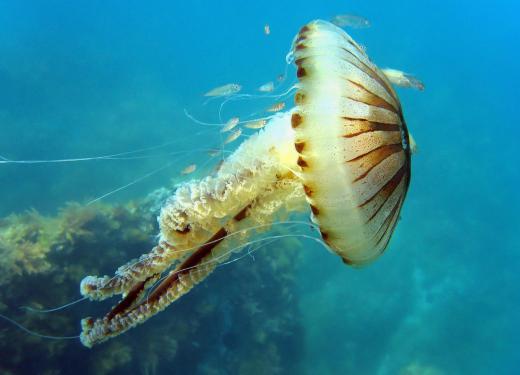What are Cnidarians?
 Michael Anissimov
Michael Anissimov
Cnidarians are a relatively simple phylum of animals (one among 38) which include the jellyfish, corals, sea pansies, sea pens, box jellies, and sea wasps. The phylum gets its name Cnidaria, from the Greek "cnidos," meaning "stinging needle."
All cnidarians, including the stationary corals (the builders of the famous and beautiful coral reefs) have stinging cells called cnidocytes, which get their sting from organelles called nematocysts (also called cnidocytes or cnidoblasts). Cnidarians are thought to be among the most basal of all animals, excepting the sponges, and fossils dating to the Ediacaran period, 580 million years ago. Cnidarians left some of the first clearly identifiable animal fossils.

There are over 10,000 species of cnidarian, divided into four main classes: Anthozoa (anemones, corals), Scyphozoa (true jellyfish), Cubozoa (box jellies) and Hydrozoa (Obelia, Aequorea, Portuguese Man o' War, others.) Two additional minor groups include Polypodium (strange parasitic cnidarians, one of the few animals to live in the cells of other animals) and Myxozoa, tiny fish/worm parasites. The classification of the latter two groups within Cnidaria is relatively recent and was made possible by genetic analysis.

Cnidarians have a reputation for being beautiful but painful, or even deadly. Each year, thousands of people are stung by jellyfish, resulting in extreme pain for many, and even death for a few. In Australia and other high-risk places, choice beaches are fenced off using nets, to protect swimmmers from the painful cnidarian touch. Particularly dangerous are the box jellies, and one species, the Irukandji jellyfish, is thought to be one of the most venomous animals on the planet. One victim stated, "I didn't think it was possible for anyone to endure that level of pain without turning into a vegetable."

Cnidarians (coral) make up the world's largest superorganism, the Great Barrier Reef in Australia, which covers an area of about 344,400 square km (132,974 sq mi). This reef, and many others around the world, have grown bit by bit over thousands of years, as coral polyps die, leaving behind their skeletons, then budding off to form new stretches of reef. These reefs are home to many sea animals, including the majestic green sea turtle.
AS FEATURED ON:
AS FEATURED ON:














Discuss this Article
Post your comments